Hyundai Azera 2008 Owner's Manual
Manufacturer: HYUNDAI, Model Year: 2008, Model line: Azera, Model: Hyundai Azera 2008Pages: 345, PDF Size: 14.61 MB
Page 141 of 345
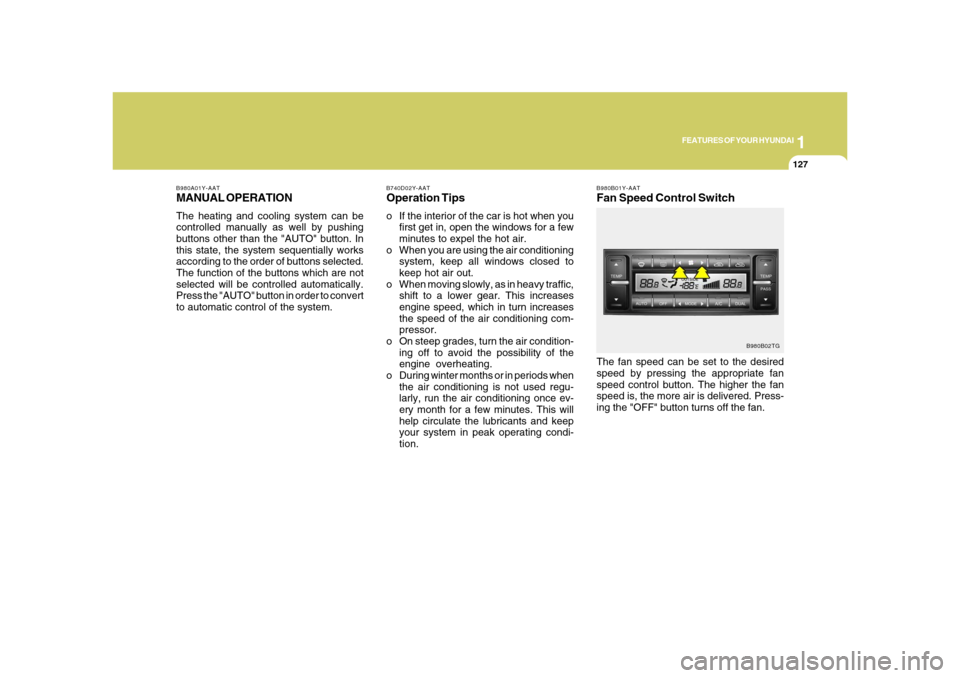
1
FEATURES OF YOUR HYUNDAI
127127
B980B01Y-AATFan Speed Control SwitchThe fan speed can be set to the desired
speed by pressing the appropriate fan
speed control button. The higher the fan
speed is, the more air is delivered. Press-
ing the "OFF" button turns off the fan.
B980B02TG B980A01Y-AAT
MANUAL OPERATIONThe heating and cooling system can be
controlled manually as well by pushing
buttons other than the "AUTO" button. In
this state, the system sequentially works
according to the order of buttons selected.
The function of the buttons which are not
selected will be controlled automatically.
Press the "AUTO" button in order to convert
to automatic control of the system.
B740D02Y-AATOperation Tipso If the interior of the car is hot when you
first get in, open the windows for a few
minutes to expel the hot air.
o When you are using the air conditioning
system, keep all windows closed to
keep hot air out.
o When moving slowly, as in heavy traffic,
shift to a lower gear. This increases
engine speed, which in turn increases
the speed of the air conditioning com-
pressor.
o On steep grades, turn the air condition-
ing off to avoid the possibility of the
engine overheating.
o During winter months or in periods when
the air conditioning is not used regu-
larly, run the air conditioning once ev-
ery month for a few minutes. This will
help circulate the lubricants and keep
your system in peak operating condi-
tion.
Page 142 of 345

1FEATURES OF YOUR HYUNDAI
128
B740A01LZ-AATAir Conditioning SwitchThe air conditioning is turned on or off by
pushing the A/C button on the heating/air
conditioning control panel.
B740A02TG
With the "Fresh" mode selected, air enters
the vehicle from the outside and is heated
or cooled according to the function se-
lected.
With the "Recirculation" mode selected,
air from within the passenger compart-
ment will be drawn through the heating
system and heated or cooled according to
the function selected.NOTE:It should be noted that prolonged opera-
tion of the heating system in "recircula-
tion" mode will give rise to fogging of the
windshield and side windows and the air
within the passenger compartment will
become stale. In addition, prolonged use
of the air conditioning with the "Recircu-
lation" mode selected may result in the
air within the passenger compartment
becoming excessively dry.
B675C01TG-AATAir Intake Control SwitchThis is used to select fresh outside air or
recirculate inside air.
To change the air intake control mode,
(Fresh mode, Recirculation mode) push
the control button.
FRESH MODE (
) : The indicator light
on the button is illuminated when the air
intake control is in fresh mode.
RECIRCULATION MODE (
) : The
indicator light on the button is illuminated
when the air intake control is in recircula-
tion mode.HTG2144-1
Page 143 of 345
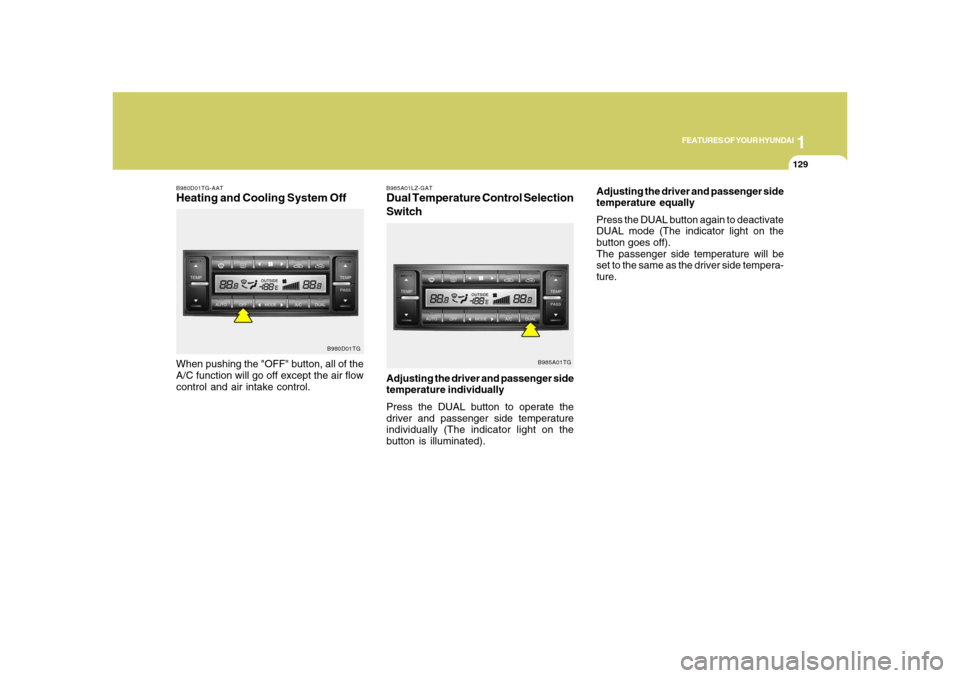
1
FEATURES OF YOUR HYUNDAI
129129
B980D01TG-AATHeating and Cooling System OffWhen pushing the "OFF" button, all of the
A/C function will go off except the air flow
control and air intake control.
B980D01TG
B985A01LZ-GATDual Temperature Control Selection
SwitchAdjusting the driver and passenger side
temperature individually
Press the DUAL button to operate the
driver and passenger side temperature
individually (The indicator light on the
button is illuminated).
B985A01TG
Adjusting the driver and passenger side
temperature equally
Press the DUAL button again to deactivate
DUAL mode (The indicator light on the
button goes off).
The passenger side temperature will be
set to the same as the driver side tempera-
ture.
Page 144 of 345
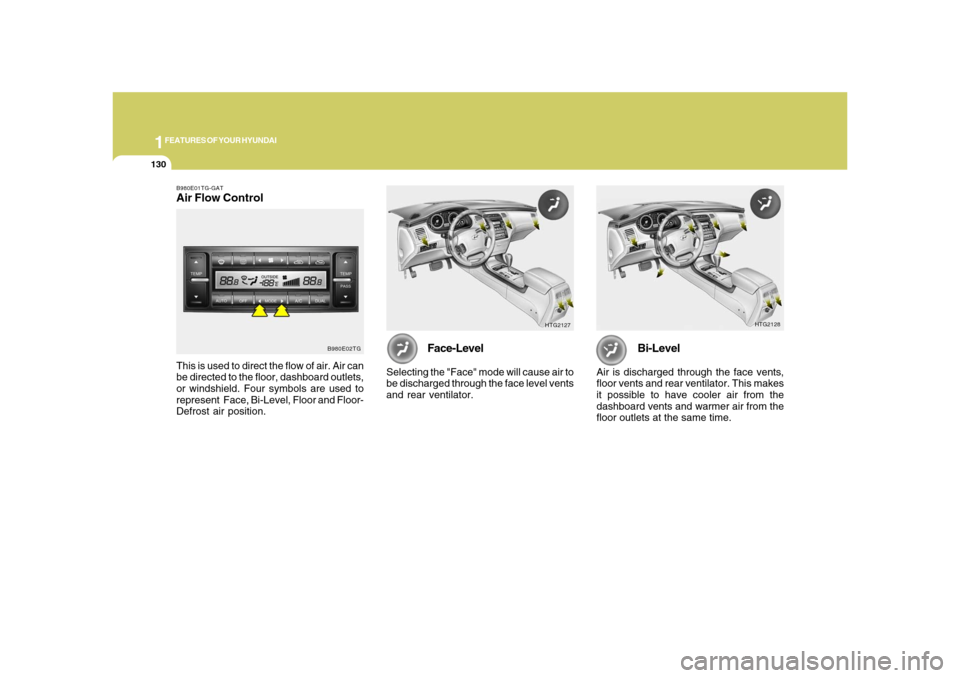
1FEATURES OF YOUR HYUNDAI
130
HTG2128
Bi-Level
Air is discharged through the face vents,
floor vents and rear ventilator. This makes
it possible to have cooler air from the
dashboard vents and warmer air from the
floor outlets at the same time.
HTG2127
Face-Level
Selecting the "Face" mode will cause air to
be discharged through the face level vents
and rear ventilator.
B980E01TG-GATAir Flow Control
B980E02TG
This is used to direct the flow of air. Air can
be directed to the floor, dashboard outlets,
or windshield. Four symbols are used to
represent Face, Bi-Level, Floor and Floor-
Defrost air position.
Page 145 of 345
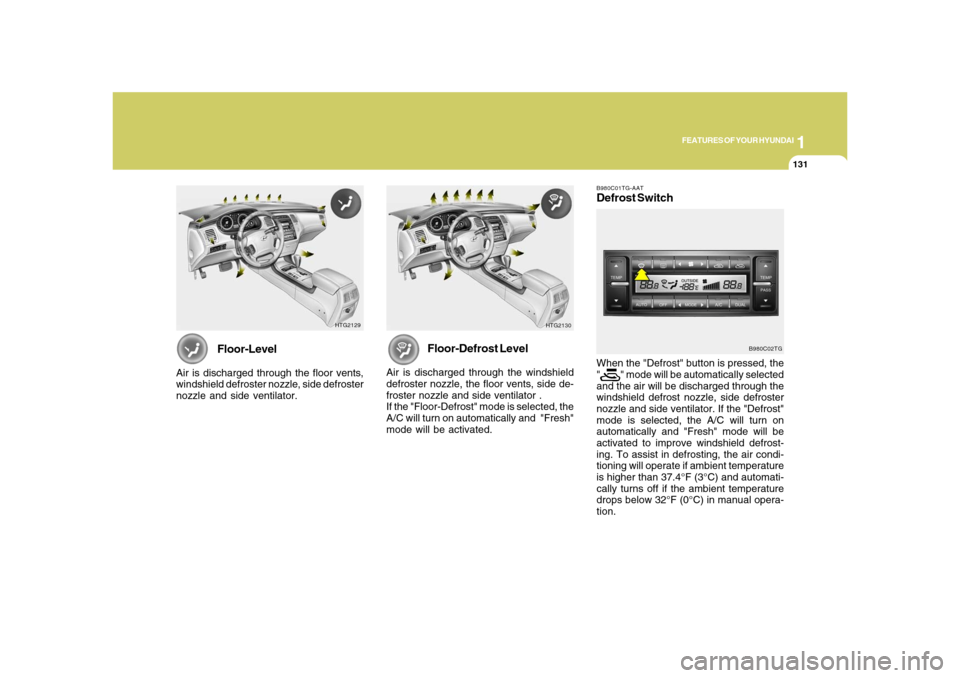
1
FEATURES OF YOUR HYUNDAI
131131
Floor-Level
Air is discharged through the floor vents,
windshield defroster nozzle, side defroster
nozzle and side ventilator.
HTG2129
HTG2130
Floor-Defrost Level
Air is discharged through the windshield
defroster nozzle, the floor vents, side de-
froster nozzle and side ventilator .
If the "Floor-Defrost" mode is selected, the
A/C will turn on automatically and "Fresh"
mode will be activated.
B980C01TG-AATDefrost SwitchWhen the "Defrost" button is pressed, the
"
" mode will be automatically selected
and the air will be discharged through the
windshield defrost nozzle, side defroster
nozzle and side ventilator. If the "Defrost"
mode is selected, the A/C will turn on
automatically and "Fresh" mode will be
activated to improve windshield defrost-
ing. To assist in defrosting, the air condi-
tioning will operate if ambient temperature
is higher than 37.4°F (3°C) and automati-
cally turns off if the ambient temperature
drops below 32°F (0°C) in manual opera-
tion.
B980C02TG
Page 146 of 345
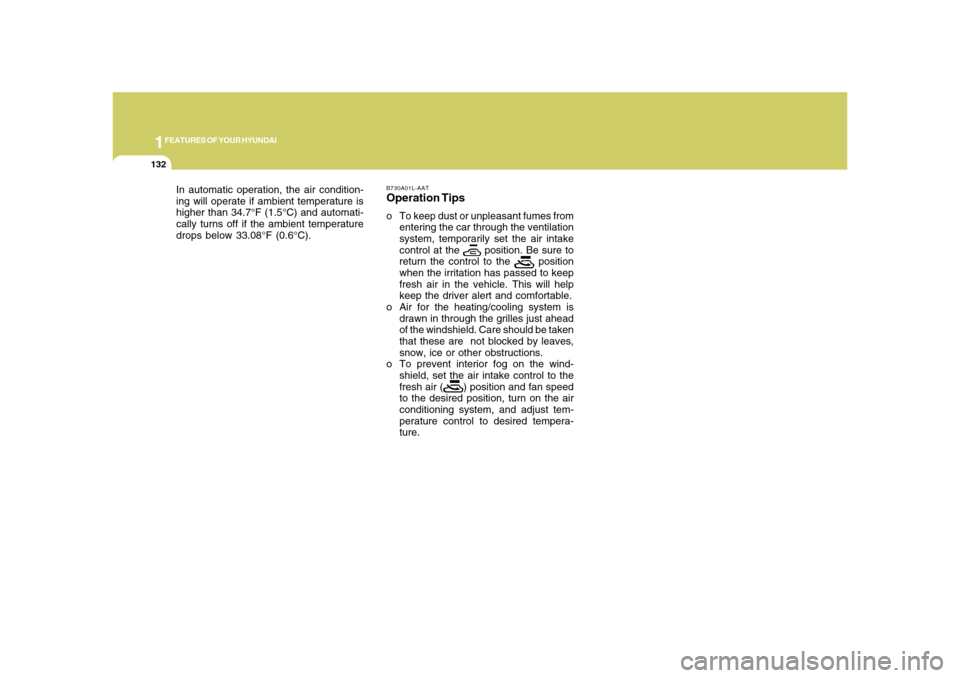
1FEATURES OF YOUR HYUNDAI
132
B730A01L-AATOperation Tipso To keep dust or unpleasant fumes from
entering the car through the ventilation
system, temporarily set the air intake
control at the
position. Be sure to
return the control to the
position
when the irritation has passed to keep
fresh air in the vehicle. This will help
keep the driver alert and comfortable.
o Air for the heating/cooling system is
drawn in through the grilles just ahead
of the windshield. Care should be taken
that these are not blocked by leaves,
snow, ice or other obstructions.
o To prevent interior fog on the wind-
shield, set the air intake control to the
fresh air (
) position and fan speed
to the desired position, turn on the air
conditioning system, and adjust tem-
perature control to desired tempera-
ture. In automatic operation, the air condition-
ing will operate if ambient temperature is
higher than 34.7°F (1.5°C) and automati-
cally turns off if the ambient temperature
drops below 33.08°F (0.6°C).
Page 147 of 345
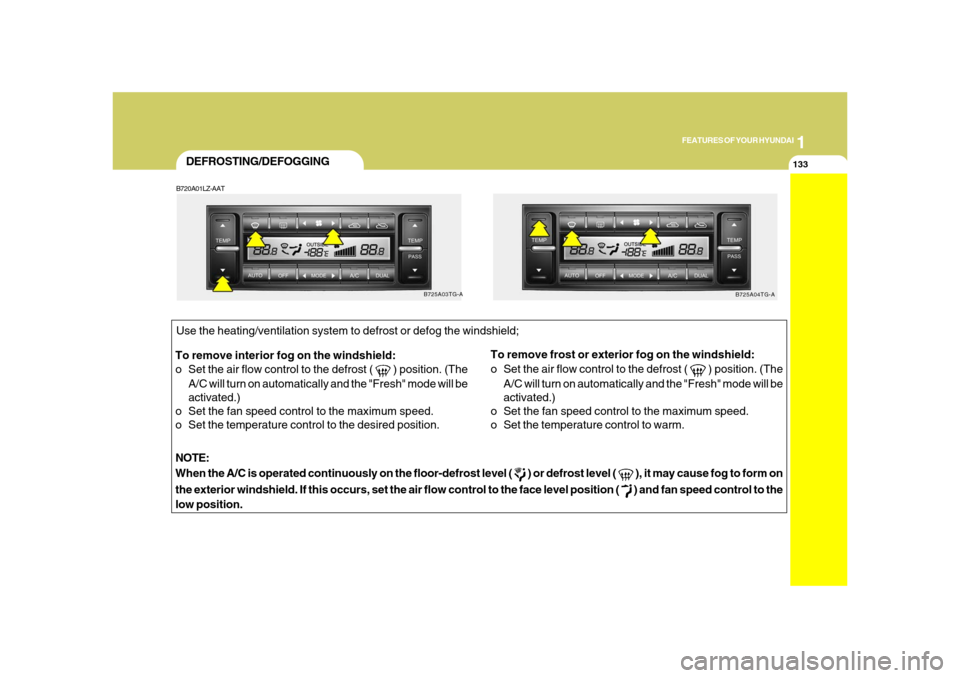
1
FEATURES OF YOUR HYUNDAI
133133
DEFROSTING/DEFOGGINGB720A01LZ-AATTo remove interior fog on the windshield:
o Set the air flow control to the defrost (
) position. (The
A/C will turn on automatically and the "Fresh" mode will be
activated.)
o Set the fan speed control to the maximum speed.
o Set the temperature control to the desired position.To remove frost or exterior fog on the windshield:
o Set the air flow control to the defrost (
) position. (The
A/C will turn on automatically and the "Fresh" mode will be
activated.)
o Set the fan speed control to the maximum speed.
o Set the temperature control to warm.
NOTE:
When the A/C is operated continuously on the floor-defrost level (
) or defrost level (
), it may cause fog to form on
the exterior windshield. If this occurs, set the air flow control to the face level position ( ) and fan speed control to the
low position.
B725A03TG-A
B725A04TG-A
Use the heating/ventilation system to defrost or defog the windshield;
Page 148 of 345
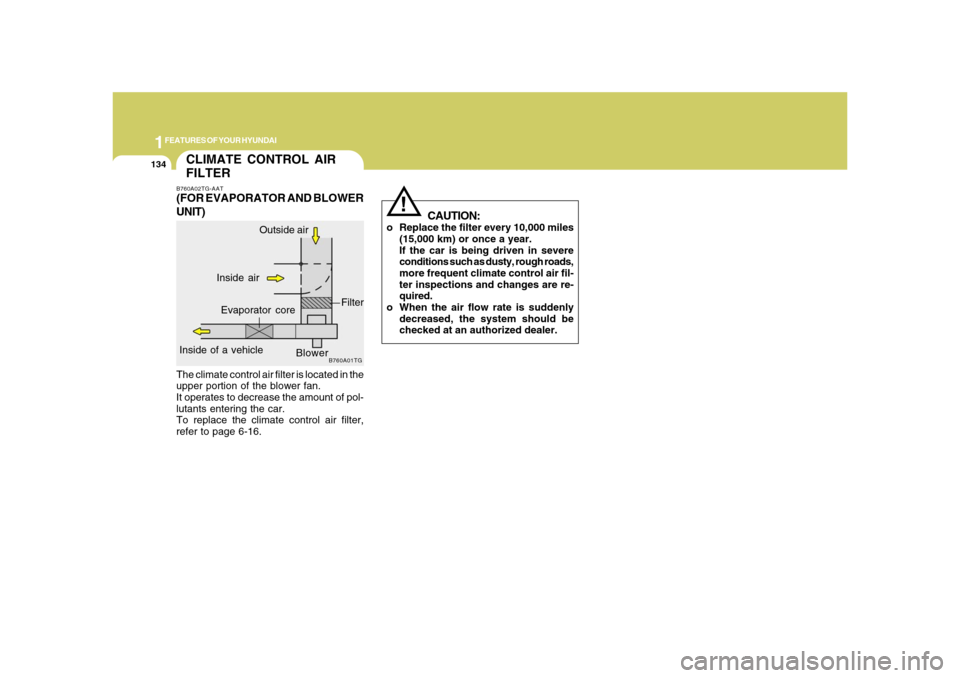
1FEATURES OF YOUR HYUNDAI
134
CAUTION:
o Replace the filter every 10,000 miles
(15,000 km) or once a year.
If the car is being driven in severe
conditions such as dusty, rough roads,
more frequent climate control air fil-
ter inspections and changes are re-
quired.
o When the air flow rate is suddenly
decreased, the system should be
checked at an authorized dealer.
!
The climate control air filter is located in the
upper portion of the blower fan.
It operates to decrease the amount of pol-
lutants entering the car.
To replace the climate control air filter,
refer to page 6-16.CLIMATE CONTROL AIR
FILTERB760A02TG-AAT(FOR EVAPORATOR AND BLOWER
UNIT)
B760A01TG
Inside of a vehicle
Evaporator coreFilter
Blower Outside air
Inside air
Page 149 of 345
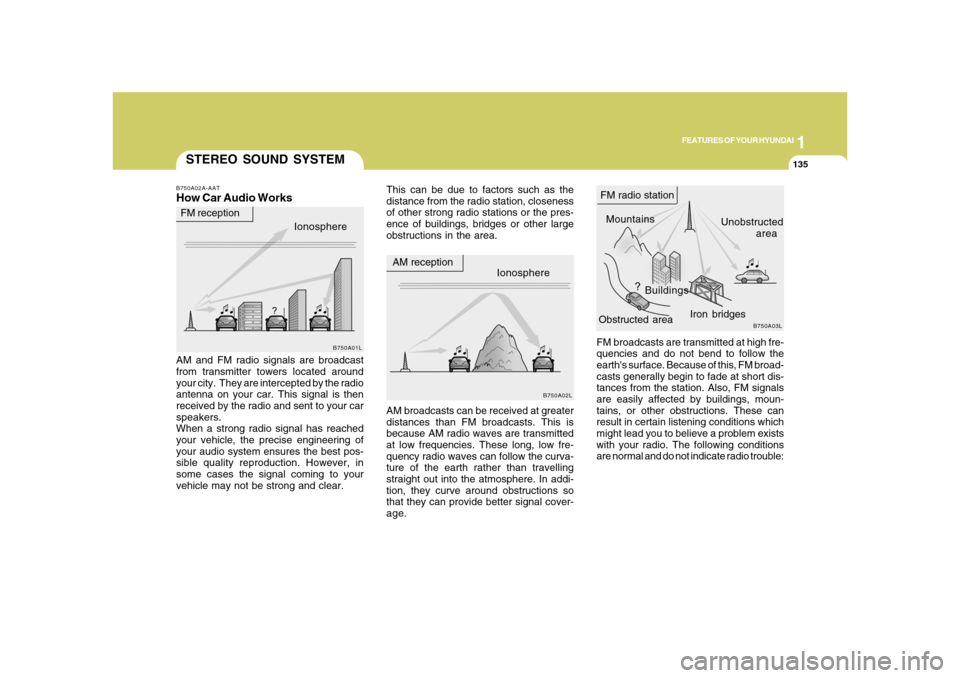
1
FEATURES OF YOUR HYUNDAI
135135
FM broadcasts are transmitted at high fre-
quencies and do not bend to follow the
earth's surface. Because of this, FM broad-
casts generally begin to fade at short dis-
tances from the station. Also, FM signals
are easily affected by buildings, moun-
tains, or other obstructions. These can
result in certain listening conditions which
might lead you to believe a problem exists
with your radio. The following conditions
are normal and do not indicate radio trouble:
STEREO SOUND SYSTEMB750A02A-AATHow Car Audio Works
This can be due to factors such as the
distance from the radio station, closeness
of other strong radio stations or the pres-
ence of buildings, bridges or other large
obstructions in the area.
AM and FM radio signals are broadcast
from transmitter towers located around
your city. They are intercepted by the radio
antenna on your car. This signal is then
received by the radio and sent to your car
speakers.
When a strong radio signal has reached
your vehicle, the precise engineering of
your audio system ensures the best pos-
sible quality reproduction. However, in
some cases the signal coming to your
vehicle may not be strong and clear.AM broadcasts can be received at greater
distances than FM broadcasts. This is
because AM radio waves are transmitted
at low frequencies. These long, low fre-
quency radio waves can follow the curva-
ture of the earth rather than travelling
straight out into the atmosphere. In addi-
tion, they curve around obstructions so
that they can provide better signal cover-
age.Ionosphere
B750A02L
AM reception
Mountains
BuildingsUnobstructed
area FM radio station
B750A03L
Ionosphere FM reception
B750A01L
Obstructed areaIron bridges
Page 150 of 345
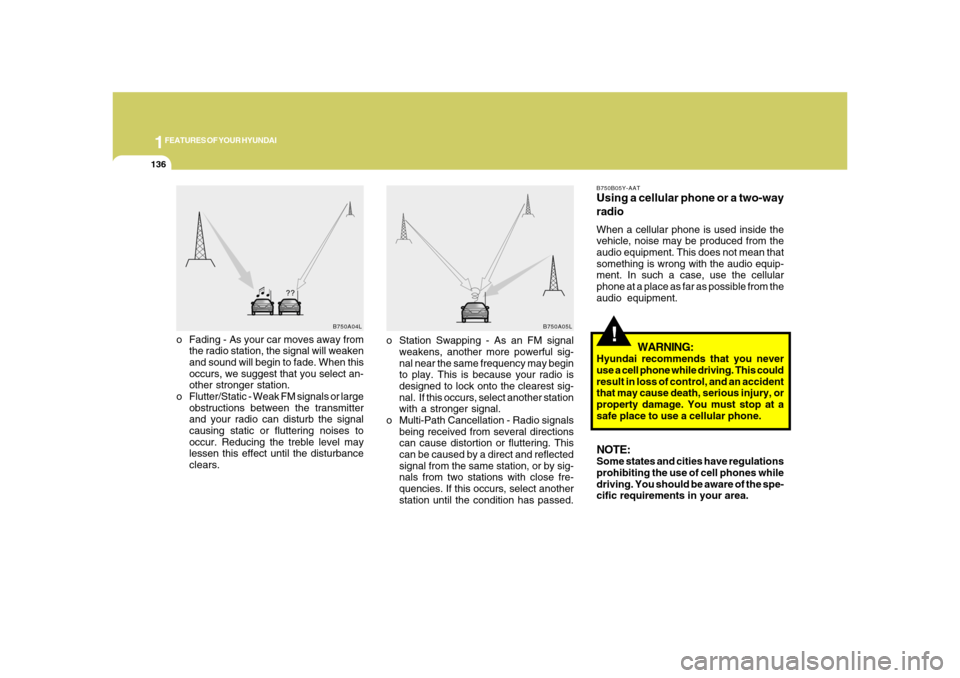
1FEATURES OF YOUR HYUNDAI
136
!
o Fading - As your car moves away from
the radio station, the signal will weaken
and sound will begin to fade. When this
occurs, we suggest that you select an-
other stronger station.
o Flutter/Static - Weak FM signals or large
obstructions between the transmitter
and your radio can disturb the signal
causing static or fluttering noises to
occur. Reducing the treble level may
lessen this effect until the disturbance
clears.
B750B05Y-AATUsing a cellular phone or a two-way
radioWhen a cellular phone is used inside the
vehicle, noise may be produced from the
audio equipment. This does not mean that
something is wrong with the audio equip-
ment. In such a case, use the cellular
phone at a place as far as possible from the
audio equipment.
WARNING:
Hyundai recommends that you never
use a cell phone while driving. This could
result in loss of control, and an accident
that may cause death, serious injury, or
property damage. You must stop at a
safe place to use a cellular phone.NOTE:Some states and cities have regulations
prohibiting the use of cell phones while
driving. You should be aware of the spe-
cific requirements in your area.
B750A04L
B750A05L
o Station Swapping - As an FM signal
weakens, another more powerful sig-
nal near the same frequency may begin
to play. This is because your radio is
designed to lock onto the clearest sig-
nal. If this occurs, select another station
with a stronger signal.
o Multi-Path Cancellation - Radio signals
being received from several directions
can cause distortion or fluttering. This
can be caused by a direct and reflected
signal from the same station, or by sig-
nals from two stations with close fre-
quencies. If this occurs, select another
station until the condition has passed.